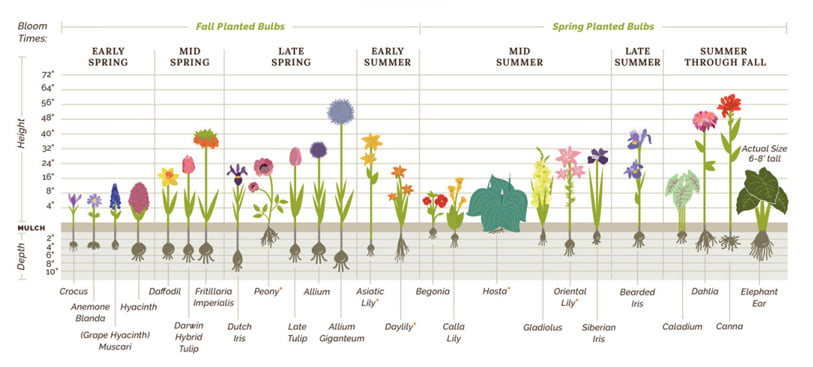If you’re looking around at your neighbors’ bulbs and longing for some of your own, now is a good time to think ahead to the fall. This area of bulbs was done using a method I learned from Martha Stewart. It might be called ‘lasagne planting’? I’m not sure, but it’s all about the layers.
The basic idea is that you dig a trench (a landscaper I talked to said that if you can dig a paisley shape, that looks most natural). Dig it to the depth necessary for your largest bulbs (as a rough guide, the bigger the bulb, the deeper it needs to go). Maybe 8″ or so for alliums?
Toss in the big bulbs — if you really want to, you can go and place them carefully so they’re pointing upwards, but if you don’t, they’ll figure it out and grow sideways and up as needed; they just might be slightly shorter than they’d otherwise be. Then shovel in a little dirt, just enough to cover.
Toss in the next layer of bulbs — tulips, perhaps. (If you’re planing tulips, think about whether you want early, middle, and late season tulips, for a long show of color.) Then a little dirt, then daffodils, then a little dirt, then crocuses, then a little dirt, then whatever spring ephemerals you like — I usually do muscari, chionodoxa, and snowdrops at least.
Once the bulbs are planted, you may want to tuck some perennials in there too — as they come up, they’ll disguise the yellowing leaves of the bulbs. (You need to leave the leaves to yellow and wither, because that’s how they soak up sun and refresh the bulb for the following year.)
Alliums and tulips tend to not be super hardy in our zone (smaller species tulips do better), so this method won’t really work forever — the alliums and tulips will reduce over a few years, and eventually, you’ll need to replant them. But it’s a good way to get a new bed of bulbs started! And daffodils and smaller bulbs will generally spread over time. Daffodils are deer, etc.-resistant too!
Remember to sprinkle a good amount of cayenne over the whole thing, to deter critters, and refresh that if it rains.
Pictured: tulips, daffodils, checkered and white fritillaries. (The daffodils are White Flower Farms’s “The Works” collection, which gives a great variety.)


